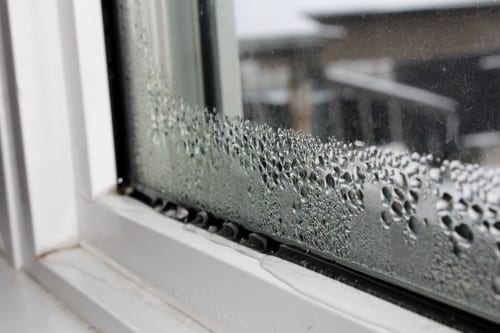Indoor condenses and humidity
Moisture condenses into water droplets when warm, humid air contacts a cool surface. Activities such as cooking, bathing, clothes drying and dish washing add moisture to the air. Some heating appliances, such as unvented natural gas or kerosene models, also increase the moisture inside your home. During the winter, windows, walls and doors that lack proper insulation are common cool surfaces. Uninsulated cold-water pipes are examples of cool surfaces in the summer. Droplets can accumulate on these surfaces and run down into the walls, windows and structural components, causing rot and peeling paint, and providing a good enviroment for mold and mildew growth.
Good to know
Humid air leads to condensation problems, but air that’s too dry can be uncomfortable or unhealthy and can lead to static shocks. Keep the relative humidity in your home between 30 – 50 percent. You can purchase a weather station that measures indoor humidity levels.
Controlling indoor moisture
When you see moisture accumulating, dry it promptly and deal with the source of the problem. Two basic elements of controlling buildup are minimizing cool surfaces and reducing humidity.
Storm doors and windows minimize cool surface in the winder by separating the interior from cold, outside air. Double and triple pane windows also insulate interior glass from the cold. In addition to reducing moisture, adding these improvements will make your home more energy- efficient year-round. Pay attention to window treatments as well. Opening drapes and blinds in the winter allows warmth to reach in the interior glass. Some condensation may occur, but the improved circulation makes it less likely to accumulate. Insulating cold-water pipes eliminates a common cool surface in warm weather. Straight and angled sleeves let you fit insulation to your pipes – just slide on the sleeves and seal the sits and joints with duct tape.
Your heating and cooling system can also help moisture in the home. Gas and electric furnaces reduce humidity with dry heat. Air conditioning lowers the moisture level in the air as it cooks. Keep registers open and unblocked to allow goof air flow, and have the system inspected and serviced regularly to make sure they are functioning properly. Caulking and weatherstripping improve energy efficiency and prevent humid air from entering a home, but they also reduce the air exchange that allows moisture to move out of the house. Bathroom exhaust fans, dryer exhaust and ducted kitchen exhaust hoods that vent to the outside remove moisture that activities such as showering, bathing, clothes drying, dish washing and cooking create. Keep the devices free of dust, lint, grease or anything that could keep them from working efficiently.
Other simple ways to reduce air moisture include :
– Covering pots while cooking, when possible.
– Leaving room doors open to allow good air circulation.
– Storing firewood outside.
– Covering aquariums.
If high humidity is a problem you can’t overcome by other methods, remove moisture from the air with a dehumidifier. They’re effective in laundry rooms, basements, bathrooms and any room that isn’t air-conditioned or has poor air circulation.
Other moisture considerations
Moisture in the home is not always as obvious as water beading on a window. Knowing other places it can accumulate can help you prevent problems. Poor ventilation in an attic can result in condensation, promoting mold growth in the framing elements of the house. This can affect your home’s structural integrity. Keep eave vents clear of insulation and make sure you have adequate air flow. A sealed, unused fireplace creates an opportunity for moisture problems. If air does’t circulate in the fireplace, condensation can accumulate on the walls and soak into the masonry. Make sure some air can flow through the fireplace, but rain cannot enter it.
If you have a crawlspace, moisture from the soil can enter your home, increasing the level of humidity. A vapor barrier over the base soil blocks the moisture, keeping it out of your living space.
Rain that seeps into your home’s foundation can lead to moisture problems. Make sure your gutters work property and direct water away from your home’s foundation.|
 StellaHome
StellaHome
